These six “experiments” by Unit 731 rank among some of the most horrifying war crimes ever committed — and they went virtually unpunished.
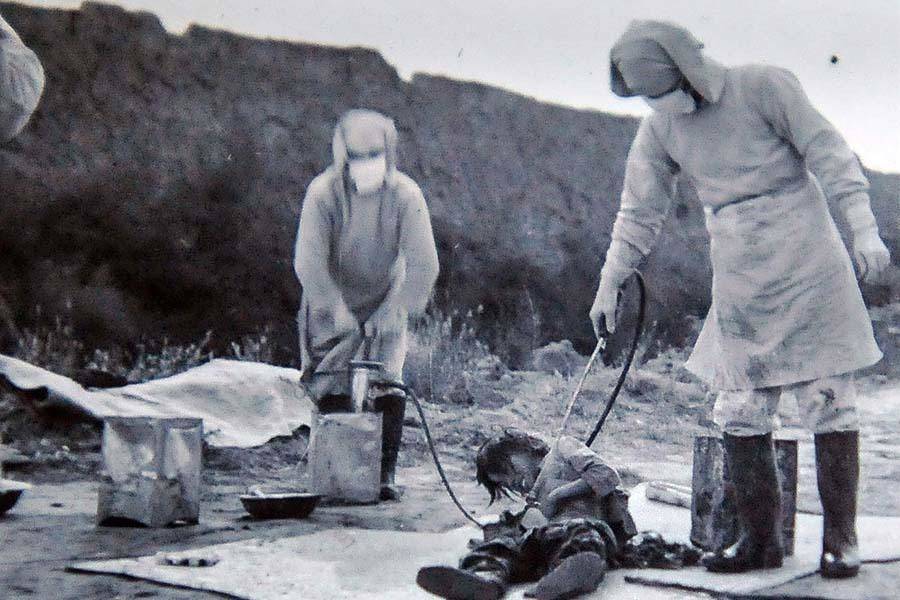
Xinhua via Getty ImagesUnit 731 personnel conduct a bacteriological trial upon a test subject in Nong’an County of northeast China’s Jilin Province. November 1940.
World War II devastated the lives of more than 100 million people around the world. And out of all the areas in which World War II was fought, none were active as long as what would come to be known as the Pacific Theater. In fact, Japan arguably started the war by attacking Manchuria in 1931, and it inarguably waged war with China by invading in 1937.
The disturbances and upheavals that these invasions caused shook China to its very foundations, triggered a civil war and a famine that probably killed more people than currently live in Canada and Australia combined, and lasted until the country’s Soviet “liberation” in 1945.
And out of all the atrocities that Imperial Japan unleashed upon the Chinese people during this brutal occupation, probably none were as gratuitously hateful as the operations of Unit 731, the Japanese Empire‘s biological warfare unit that somehow plumbed new depths in what was already a genocidal war.
Despite innocent beginnings as a research and public health agency, Unit 731 eventually grew into an assembly line for weaponized diseases that, if fully deployed, could have killed everyone on Earth several times over. All this “progress” was, of course, built on the limitless suffering of human captives, who were held as test subjects and walking disease incubators until Unit 731 was shut down at the end of the war.
But before Unit 731 was broken up in 1945, it committed some of the most torturous human experiments in recorded history.
Unit 731 Experiments: Frostbite Testing
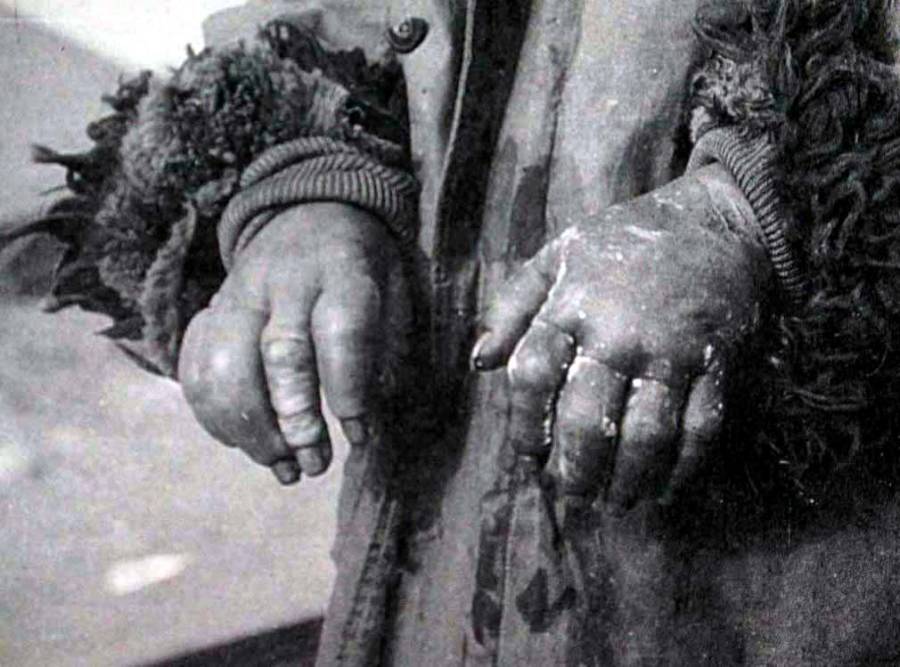
Xinhua via Getty ImagesThe frostbitten hands of a Chinese person who was taken outside in winter by Unit 731 personnel for an experiment on how best to treat frostbite. Date unspecified.
Yoshimura Hisato, a physiologist assigned to Unit 731, took a special interest in hypothermia. As part of Maruta’s study in limb injuries, Hisato routinely submerged captives’ limbs in a tub of water filled with ice and had them held until the arm or leg had frozen solid and a coat of ice had formed over the skin. According to one eyewitness account, the limbs made a sound like a plank of wood when struck with a cane.
Hisato then tried different methods for rapid rewarming of the frozen appendage. Sometimes he did this by dousing the limb with hot water, sometimes by holding it close to an open fire, and other times by leaving the subject untreated overnight to see how long it took for the person’s own blood to thaw it out.
Vivisection Of Conscious Captives
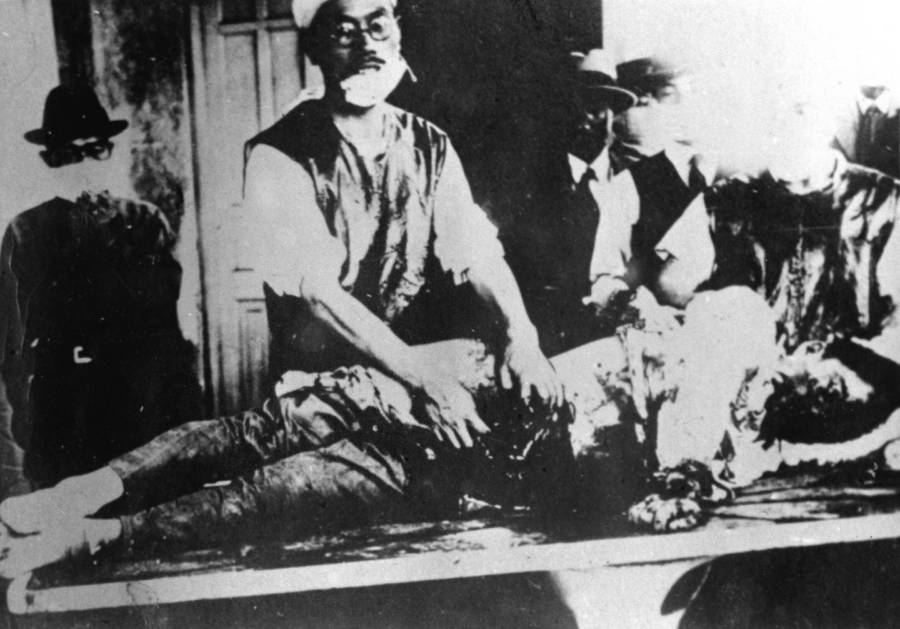
Xinhua via Getty ImagesA Unit 731 doctor operates on a patient that is part of a bacteriological experiment. Date unspecified.
Unit 731 started out as a research unit, investigating the effects of disease and injury on the fighting ability of an armed force. One element of the unit, called “Maruta,” took this research a little further than the usual bounds of medical ethics by observing injuries and the course of disease on living patients.
At first, these patients were volunteers from the ranks of the army, but as the experiments reached the limits of what could be non-invasively observed, and as the supply of volunteers dried up, the unit turned to the study of Chinese POWs and civilian captives.
And as the concept of consent went out the window, so did the restraint of the researchers. It was around this time that Unit 731 began referring to confined research subjects as “logs,” or “Maruta” in Japanese.
Study methods in these experiments were barbaric.
Vivisection, for example, is the practice of mutilating human bodies, without anesthesia, to study the operations of living systems. Thousands of men and women, mostly Chinese communist captives as well as children and elderly farmers, were infected with diseases such as cholera and the plague, then had their organs removed for examination before they died in order to study the effects of the disease without the decomposition that occurs after death.
Subjects had limbs amputated and reattached to the other side of the body, while others had their limbs crushed or frozen, or had the circulation cut off to observe the progress of gangrene.
Finally, when a prisoner’s body was all used up, they would typically be shot or killed by lethal injection, though some may have been buried alive. None of the Chinese, Mongolian, Korean, or Russian captives assigned to Unit 731 survived their confinement.
Unit 731’s Horrifying Weapons Tests
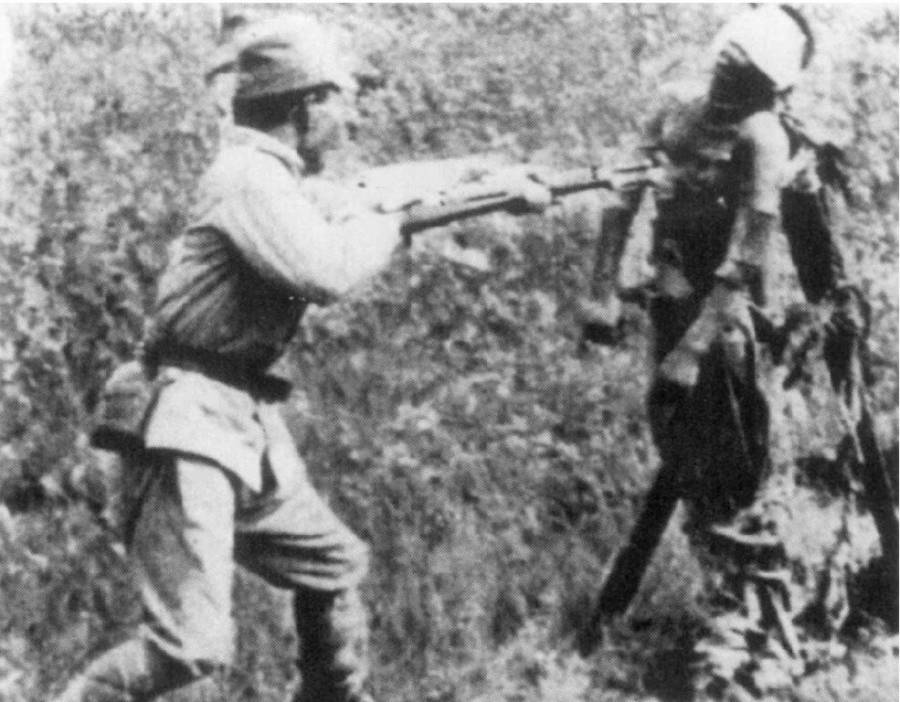
Associated Press/LIFE via Wikimedia CommonsA Japanese soldier uses a Chinese man’s body for bayonet practice near Tianjin, China. September 1937.
The effectiveness of various weapons was of obvious interest to the Japanese Army. To determine effectiveness, Unit 731 herded captives together on a firing range and blasted them from varying ranges by multiple Japanese weapons, such as the Nambu 8mm pistol, bolt-action rifles, machine guns, and grenades. Wound patterns and penetration depths were then compared on the bodies of the dead and dying inmates.
Bayonets, swords, and knives were also studied in this way, though the victims were usually bound for these tests. Flamethrowers were also tested, on both covered and exposed skin. In addition, gas chambers were set up at unit facilities and test subjects exposed to nerve gas and blister agents.
Heavy objects were dropped onto bound victims to study crush injuries, subjects were locked up and deprived of food and water to learn how long humans could survive without them, and victims were allowed to drink only sea water, or were given injections of mismatched human or animal blood to study transfusions and the clotting process.
Meanwhile, prolonged X-ray exposure sterilized and killed thousands of research participants, as well as inflicting horrible burns when the emitting plates were miscalibrated or held too close to the subjects’ nipples, genitals, or faces.
And to study the effects of high G-forces on pilots and falling paratroopers, Unit 731 personnel loaded human beings into large centrifuges and spun them at higher and higher speeds until they lost consciousness and/or died, which usually happened around 10 to 15 G’s, though young children showed a lower tolerance for acceleration forces.
Syphilis Experiments On Unit 731 Captives
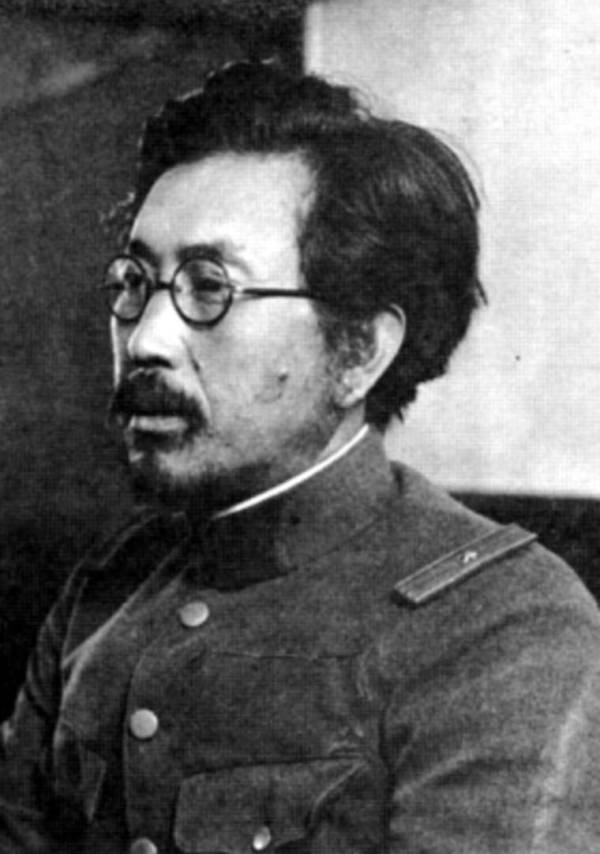
Wikimedia CommonsGeneral Shiro Ishii, the commander of Unit 731.
Venereal disease has been the bane of organized militaries since ancient Egypt, and so it stands to reason that the Japanese military would take an interest in the symptoms and treatment of syphilis.
To learn what they needed to know, doctors assigned to Unit 731 infected victims with the disease and withheld treatment to observe the uninterrupted course of the illness. A contemporary treatment, a primitive chemotherapy agent called Salvarsan, was sometimes administered over a period of months to observe the side effects, however.
To ensure effective transmission of the disease, syphilitic male victims were ordered to rape both female and male fellow captives, who would then be monitored to observe the onset of the disease. If the first exposure failed to establish infection, more rapes would be arranged until it did.
Rape And Forced Pregnancy

Wikimedia CommonsUnit 731’s Harbin facility.
Beyond just the syphilis experiments, rape became a common feature of Unit 731’s experiments.
For example, female captives of childbearing age were sometimes forcibly impregnated so that weapon and trauma experiments could be done on them.
After being infected with various diseases, exposed to chemical weapons, or suffering crush injuries, bullet wounds, and shrapnel injuries, the pregnant subjects were opened up and the effects on the fetuses studied.
The idea seems to have been to translate the teams’ findings into civilian medicine, but if Unit 731’s researchers ever published these results, the papers seem not to have survived the war years.
Germ Warfare On Chinese Civilians
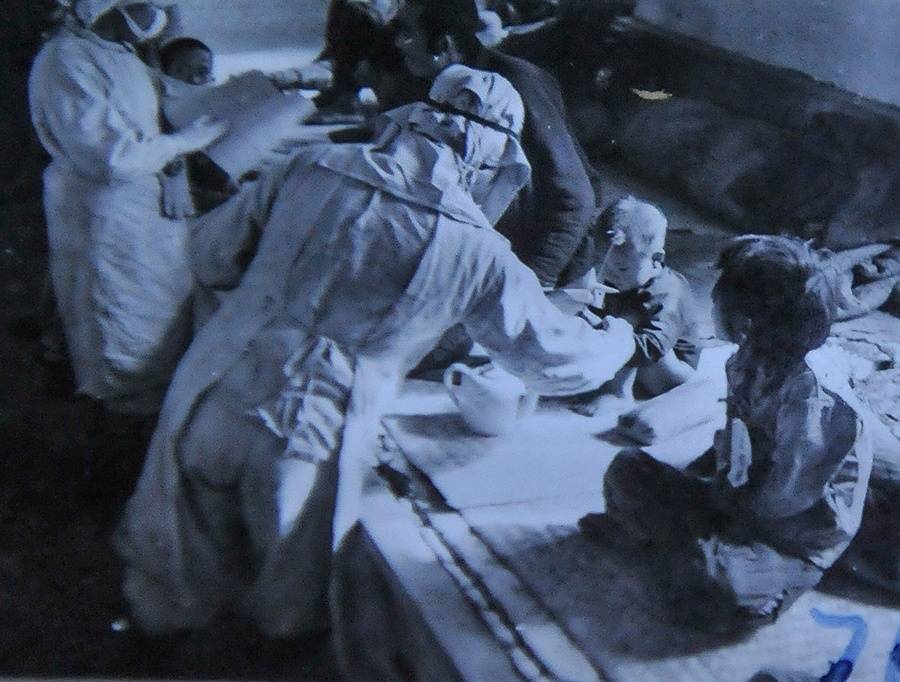
Xinhua via Getty ImagesUnit 731 researchers conduct bacteriological experiments with captive child subjects in Nongan County of northeast China’s Jilin Province. November 1940.
The totality of Unit 731’s research was in support of their larger mission, which by 1939 was to develop horrific weapons of mass destruction for use against the Chinese population, and presumably American and Soviet forces, if the time ever came.
To this end, Unit 731 cycled through tens of thousands of captives at several facilities across Manchuria, which had been occupied by imperial forces for years. Inmates of these facilities were infected with several of the most lethal pathogens known to science, such as Yersinia pestis, which causes bubonic and pneumonic plague, and typhus, which the Japanese hoped would spread from person to person after being deployed and depopulate disputed areas.
To breed the most lethal strains possible, doctors monitored patients for rapid onset of symptoms and quick progression. Victims who pulled through were shot, but those who got sickest fastest were bled to death on a mortuary table, and their blood was used to transfect other captives, the sickest of whom would themselves be bled to transfer the most virulent strain to yet another generation.
One member of Unit 731 later recalled that very sick and unresisting captives would be laid out on the slab so a line could be inserted into their carotid artery. When most of the blood had been siphoned off and the heart was too weak to pump anymore, an officer in leather boots climbed onto the table and jumped on the victim’s chest with enough force to crush the ribcage, whereupon another dollop of blood would spurt into the container.
When the plague bacillus had been bred to what was felt to be a sufficiently lethal caliber, the last generation of victims to be infected were exposed to huge numbers of fleas, Y. pestis’ preferred vector of contagion. The fleas were then packed in dust and sealed inside clay bomb casings.
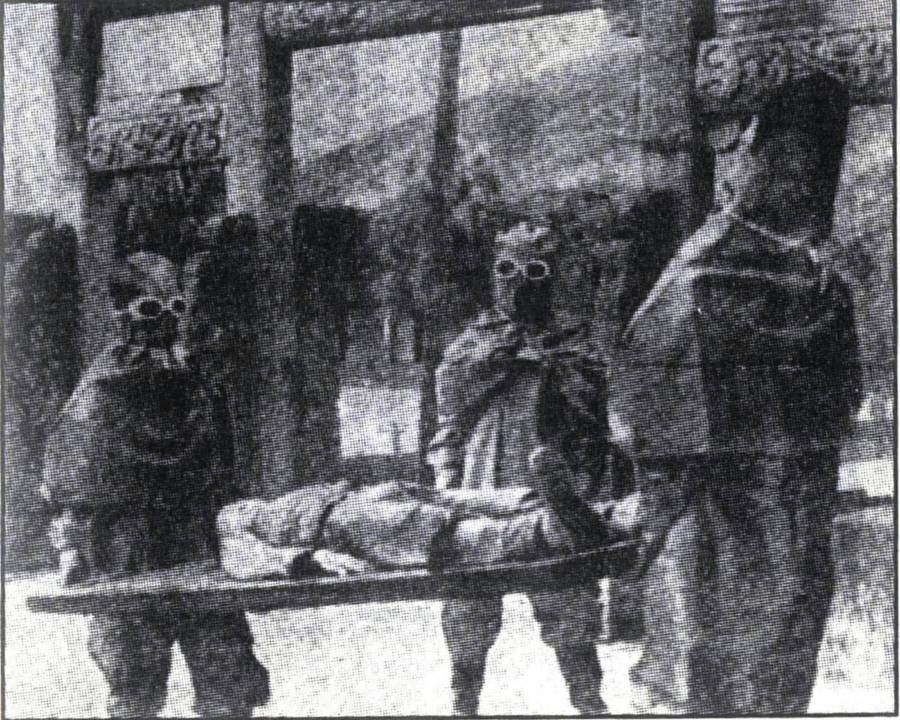
Xinhua via Getty ImagesJapanese personnel in protective suits carry a stretcher through Yiwu, China during Unit 731’s germ warfare tests. June 1942.
On October 4, 1940, Japanese bombers deployed these casings, each loaded with 30,000 fleas that had each sucked blood from a dying prisoner, over the Chinese village of Quzhou. Witnesses to the raid recall a fine reddish dust settling on surfaces all over town, followed by a rash of painful flea bites that afflicted nearly everyone.
From contemporary accounts, it is known that more than 2,000 civilians died of plague following this attack, and that another 1,000 or so died in nearby Yiwu after the plague was carried there by sick railway workers. Other attacks, using anthrax, killed approximately 6,000 more people in the area.
A few years later, as the war was nearing its end, Japan likewise planned to bomb America with plague-ridden fleas, but never got the chance. In August 1945, after Hiroshima and Nagasaki had both been bombed, the Soviet Army had invaded Manchuria and utterly annihilated the Japanese Army, and the emperor read his infamous surrender declaration over the radio, Unit 731 was officially disbanded.
Its records were mostly burned, destroying any useful information the team had managed to generate in 13 years of research. Researchers mostly slipped back into civilian life in occupied Japan as if nothing had ever happened, many of them becoming prominent members of university faculty.
To this day, Japan has not apologized for, and China has not forgiven, the countless atrocities Japanese forces visited upon China between 1931 and 1945 during the Second Sino-Japanese War and beyond. As the last witnesses to this history grow old and die, it’s possible that the matter will never be addressed again.